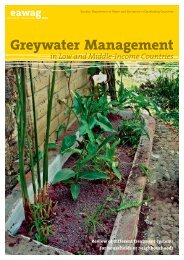Household Water Treatment and Safe Storage Factsheet: Source ...
Household Water Treatment and Safe Storage Factsheet: Source ...
Household Water Treatment and Safe Storage Factsheet: Source ...
You also want an ePaper? Increase the reach of your titles
YUMPU automatically turns print PDFs into web optimized ePapers that Google loves.
<strong>Household</strong> <strong>Water</strong> <strong>Treatment</strong> for Fluoride Removal<br />
<strong>Factsheet</strong>: Bone Char Filter<br />
Potential <strong>Treatment</strong> Capacity<br />
Very Effective For: Somewhat Effective For: Not Effective For:<br />
Fluoride<br />
Taste, odour, colour<br />
Turbidity<br />
Other Chemicals<br />
Bacteria<br />
Viruses<br />
Protozoa<br />
Helminths<br />
Hardness<br />
What Is a Bone Char Filter?<br />
Bone was one of the earliest media suggested<br />
for fluoride removal from water. It was not<br />
widely implemented due to the bad taste of<br />
treated water, the high cost <strong>and</strong> unavailability.<br />
But in 1988, the WHO claimed it to be an<br />
applicable technology for developing countries.<br />
Bone char is a blackish porous granular media<br />
capable of absorbing a range of contaminants.<br />
The bone char grains are packed in a filter<br />
(bucket, drum or column) <strong>and</strong> water flows<br />
through.<br />
Bone char is made from animal bones that are<br />
charred (burnt) <strong>and</strong> crushed. Correct<br />
preparation of the bone char is essential to<br />
ensure good fluoride removal <strong>and</strong> to avoid<br />
unattractive taste, colour <strong>and</strong> odour in the<br />
treated water. Decades ago, bone char was<br />
industrially produced <strong>and</strong> widely available, but<br />
now the supply is limited. However, bone char<br />
grains can be produced locally by<br />
communities.<br />
How Does It Remove Contamination?<br />
Major components of bone char are calcium<br />
phosphate, activated carbon <strong>and</strong> calcium<br />
carbonate. Fluoride is removed from water<br />
through a process based on ion exchange.<br />
When raw water containing fluoride comes into<br />
contact with bone char, the fluoride ion<br />
changes places with the carbonate ion in the<br />
bone char, <strong>and</strong> the fluoride becomes “stuck” to<br />
the bone char.<br />
Bone char has high fluoride removal efficiency,<br />
<strong>and</strong> can also absorb a wide range of other<br />
contaminants. The fluoride adsorption capacity<br />
is 2mg fluoride per gram of bone char<br />
(Albertus, 2000).<br />
Operation<br />
Bone Char Production<br />
The steps for preparing bone char are:<br />
charring, crushing, sieving <strong>and</strong> washing/drying.<br />
The colour of the charred bone is a simple way<br />
to determine its quality (Jacobsen <strong>and</strong> Dahi,<br />
1997):<br />
<br />
<br />
<br />
Grey-brownish: Highest fluoride removal<br />
Black: Still contains organic impurities<br />
causing odour <strong>and</strong> colour<br />
White: Reduced fluoride removal capacity<br />
Bone char from any animal needs to be<br />
carbonized at a temperature of 400 to 500 ºC<br />
with a controlled air supply. Then the charred<br />
bones can be crushed manually or by using a<br />
crushing machine. Particles between 0.5 mm<br />
<strong>and</strong> 4 mm can be used as media.<br />
Three Common <strong>Household</strong>s Units for Sorption<br />
Defluoridation (Credit: WHO, 2006)
















